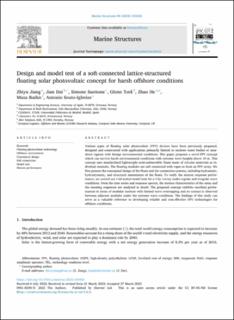| dc.contributor.author | Jiang, Zhiyu | |
| dc.contributor.author | Dai, Jian | |
| dc.contributor.author | Saettone, Simone | |
| dc.contributor.author | Tørå, Glenn | |
| dc.contributor.author | He, Zhao | |
| dc.contributor.author | Bashir, Musa | |
| dc.contributor.author | Souto-Iglesias, Antonio | |
| dc.date.accessioned | 2023-04-18T11:50:24Z | |
| dc.date.available | 2023-04-18T11:50:24Z | |
| dc.date.created | 2023-04-13T22:30:30Z | |
| dc.date.issued | 2023 | |
| dc.identifier.citation | Jiang, Z., Dai, J., Saettone, S., Tørå, G., He, Z., Bashir, M. & Souto-Iglesias, A. (2023). Design and model test of a soft-connected lattice-structured floating solar photovoltaic concept for harsh offshore conditions. Marine Structures, 90. | en_US |
| dc.identifier.issn | 0951-8339 | |
| dc.identifier.uri | https://hdl.handle.net/11250/3063568 | |
| dc.description.abstract | Various types of floating solar photovoltaic (FPV) devices have been previously proposed, designed and constructed with applications primarily limited to onshore water bodies or nearshore regions with benign environmental conditions. This paper proposes a novel FPV concept which can survive harsh environmental conditions with extreme wave heights above 10 m. This concept uses standardised lightweight semi-submersible floats made of circular materials as individual modules. The floating modules are soft connected with ropes to form an FPV array. We first present the conceptual design of the floats and the connection systems, including hydrostatic, hydrodynamic, and structural assessments of the floats. To verify the motion response performance, we carried out 1:60 scaled model tests for a 2 by 3 array under regular and irregular wave conditions. From the time series and response spectra, the motion characteristics of the array and the mooring responses are analysed in detail. The proposed concept exhibits excellent performances in terms of modular motions with limited wave overtopping and no contact is observed between adjacent modules under the extreme wave conditions. The findings of this study can serve as a valuable reference to developing reliable and cost-effective FPV technologies for offshore conditions. | en_US |
| dc.language.iso | eng | en_US |
| dc.publisher | Elsevier | en_US |
| dc.rights | Attribution-NonCommercial-NoDerivatives 4.0 Internasjonal | * |
| dc.rights.uri | http://creativecommons.org/licenses/by-nc-nd/4.0/deed.no | * |
| dc.title | Design and model test of a soft-connected lattice-structured floating solar photovoltaic concept for harsh offshore conditions | en_US |
| dc.type | Journal article | en_US |
| dc.type | Peer reviewed | en_US |
| dc.description.version | publishedVersion | en_US |
| dc.rights.holder | © 2023 The Author(s) | en_US |
| dc.subject.nsi | VDP::Teknologi: 500::Informasjons- og kommunikasjonsteknologi: 550 | en_US |
| dc.source.pagenumber | 25 | en_US |
| dc.source.volume | 90 | en_US |
| dc.source.journal | Marine Structures | en_US |
| dc.identifier.doi | 10.1016/j.marstruc.2023.103426 | |
| dc.identifier.cristin | 2140739 | |
| dc.source.articlenumber | 103426 | en_US |
| cristin.qualitycode | 2 | |

